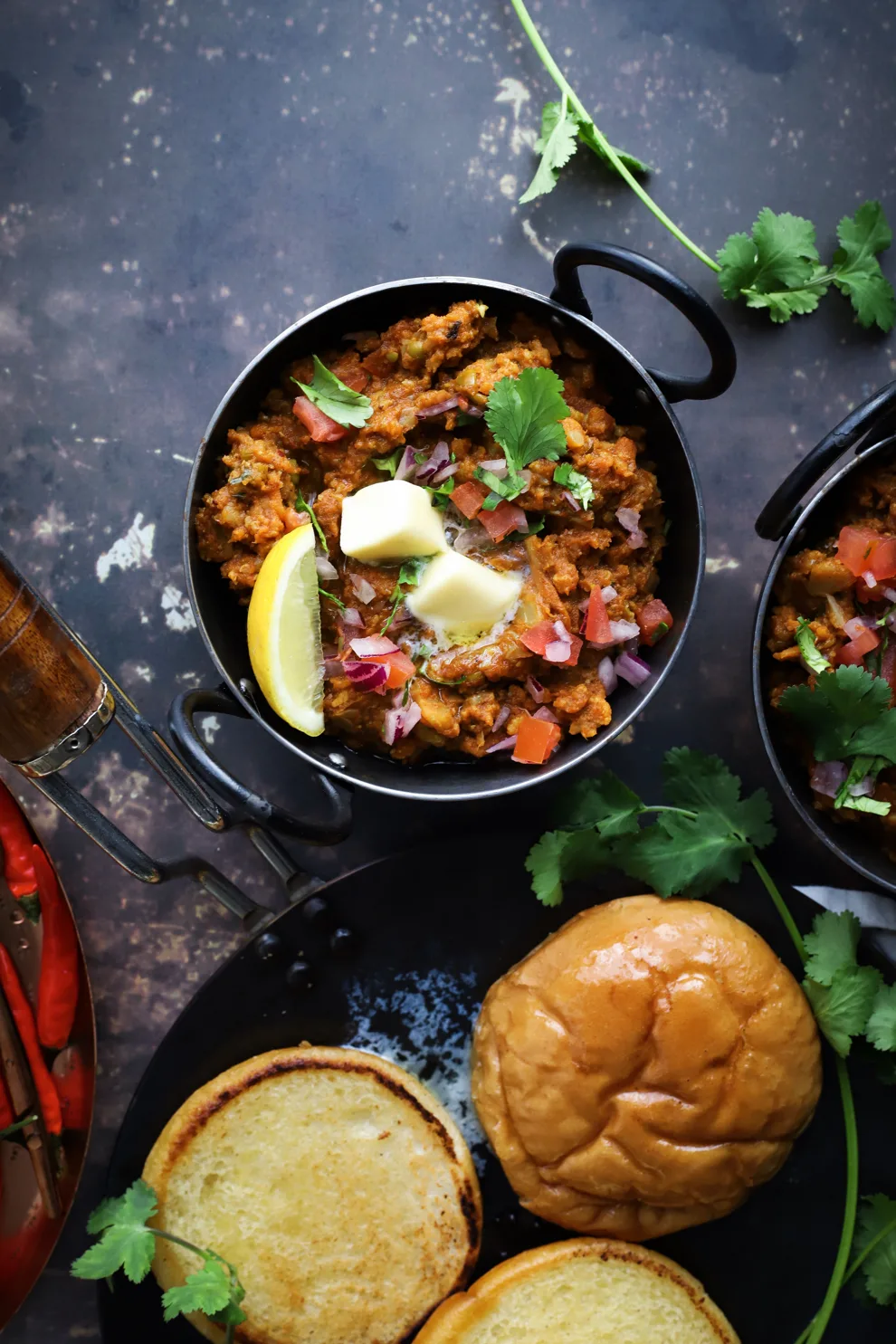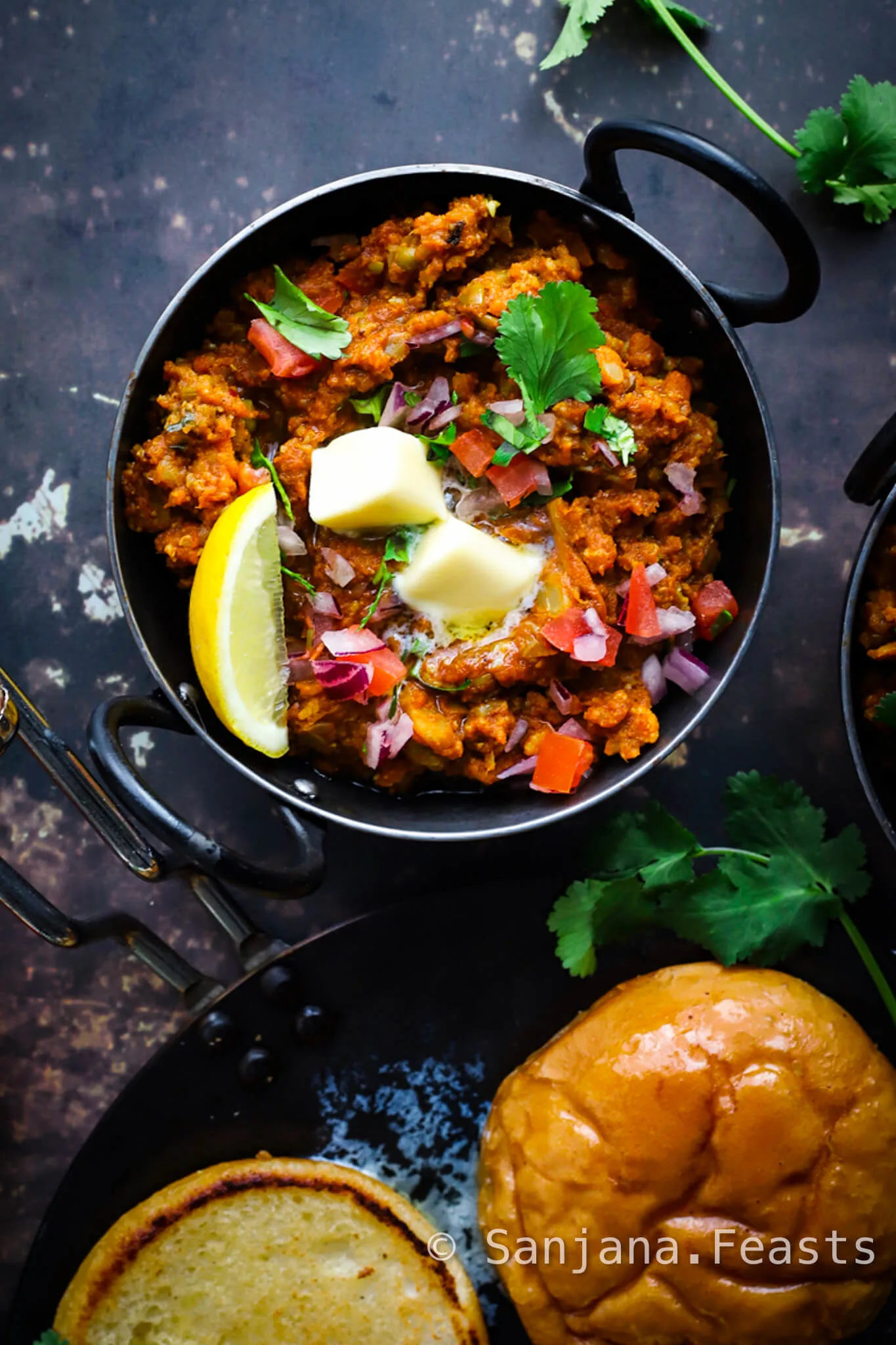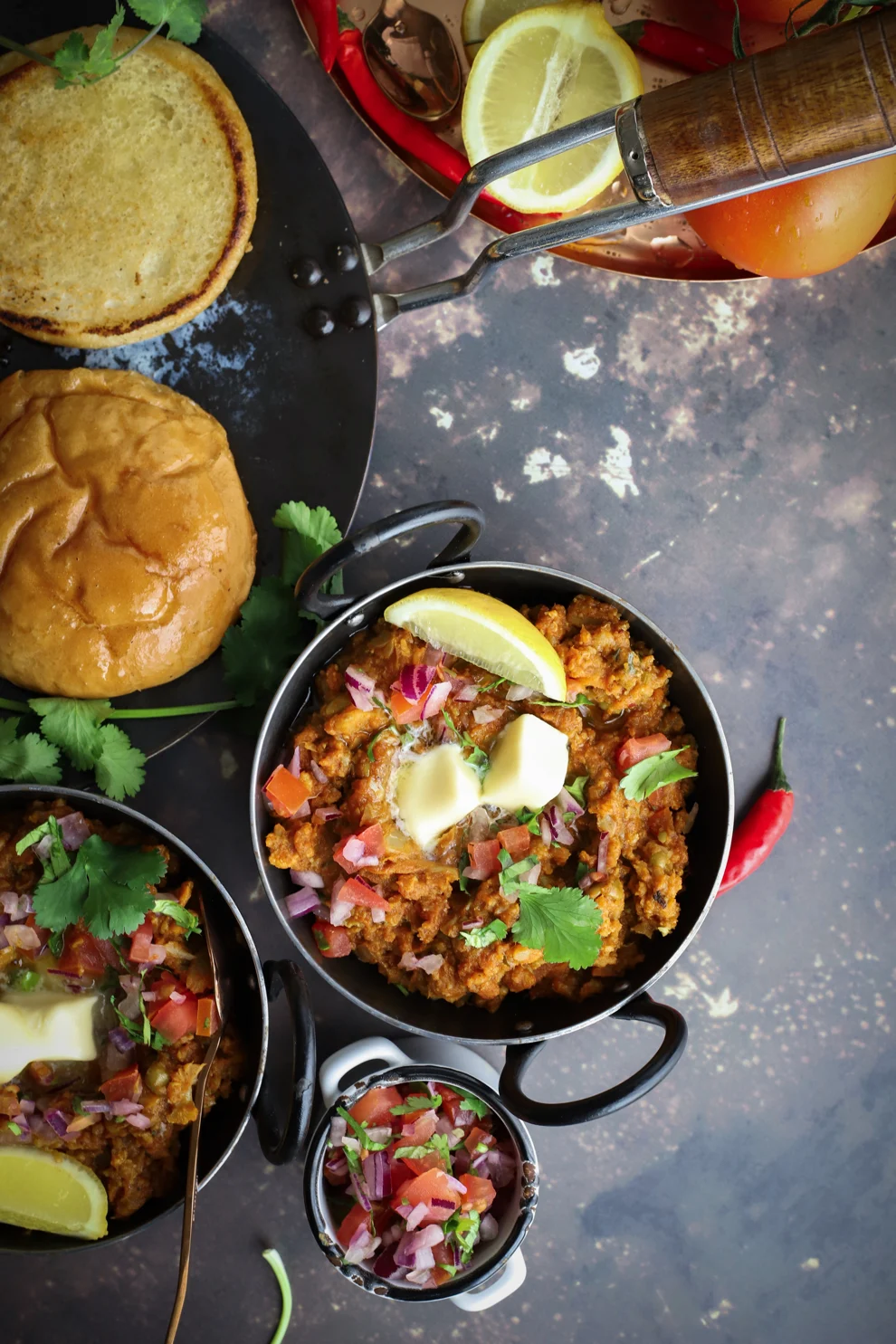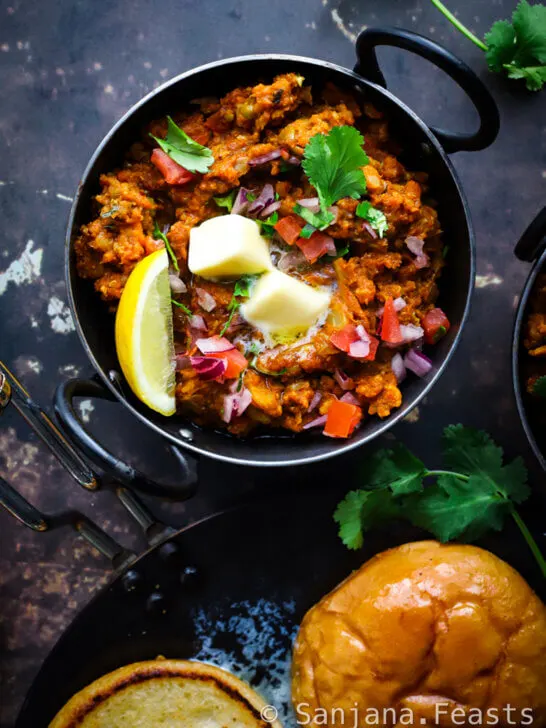Grab a napkin because this Melt-in-the-Mouth Butter Pau Bhaji is an Indian vegetarian street food sensation that’s loaded with buttery warmth.
Pau Bhaji is a combination of mashed vegetables spiced with a blend of fiery masala and served with toasted bread buns.
“Tak-tak-tak-tak-tak” went the metal potato masher against the tyre-sized pan.
The fire beneath it was roaring and the smell of kerosine in the air was only making the lava-like Pau Bhaji smell more delicious.
The skilled street vendor was hand pounding the spicy vegetable curry within an inch of its’ life whilst juggling another giant cooking vessel to his left.
On top of the second pan was foaming butter, ready to become one with the fluffy white rolls, known locally as Ladi pav.
After a few seconds, they would be sporting a crisp, golden crust ready to be served with yet more butter, finely-diced onions, tomatoes and coriander.
A wedge of lemon would complete the dish. I was about to dive in to my first Pau Bhaji on the streets of Old Town, Mombasa.
With the bustling crowds and honking horns of oncoming traffic, I could have easily been in a buzzing Mumbai back street.

For me, the Indian food of East Africa is some of the most delicious food that exists. There’s no shying away from scorching hot chillies and the tang of lemon.
This combo seasons everything you eat, wherever you go and whatever you order.
From raw mangos on the beach, to fire-roasted maize and fried cassava chips on the salty-aired streets, it’s the typical seasoning Kenya’s rustic coastal towns.
I hope to visit India to enjoy street-style Pau Bhaji in its birthplace of Maharashtra, India, but my first experience of eating this iconic street dish was in Kenya, the home of my Indian immigrant grandparents.
Pau Bhaji is a great dish to make for big get-togethers.
It’s easy to scale the recipe up to feed more, since the rolls (pav) are almost always shop-bought and making more curry (bhaji) simply requires doubling up the veggies and sliding in some more masala.

How to make Pau Bhaji masala
My Pau Bhaji masala is magic dust. Not only is it a beautiful blend for this buttery vegetable dish, it also makes daal more delicious and peps up any Pulao (Indian fried rice).
I often make up a triple batch of the masala recipe below and store it in an airtight container for using in other dishes.
For this recipe, just work with the measurements below and use it all in the Bhaji recipe.
It might look excessive but trust me, your buttery veggies are crying out for some spice.
Pau bhaji masala recipe
- 1 tbsp garam masala
- 2 tsp red chilli powder
- 1 tsp ground cinnamon
- 1 tsp ground fennel seeds
- 1 tsp ground coriander
- 1 tsp ground cumin seeds
- 1 tsp ground turmeric
- 2 cardamom pods, seeds crushed
What vegetables should I use for Pau Bhaji?
The beauty of Pau Bhaji is that you can use any vegetables you like, since they’re all getting mashed like crazy anyway. The most common ones are potatoes, cauliflower, peas and carrots.
This also happens to be my favourite combination but feel free to add red peppers, aubergine and green beans if you like those.
I typically add in some sweet potatoes for colour and sweetness without having to add sugar or food colouring.
It’s very common for some street vendors to add red food colouring to their Bhaji for a rich appearance.
I find a combination of tomato passata (sieved tomatoes), sweet potatoes, turmeric and Kashmiri chilli powder do a great job of giving my bhaji a deliciously-deep colour without having to do that.
Use your judgment and add it if you like though.

This is one of those dishes where the garnishes are as important as the main component of the food itself.
Don’t skip the lemon wedges, finely diced red onions, tomatoes and coriander topping. And don’t skip the extra butter on top either. It adds the special, indulgent touch that separates good Pau Bhaji from average Pau Bhaji.
Nobody remembers average Pau Bhaji.
What bread should I use for Pau Bhaji?
Lastly, the bread must be soft, white and most importantly, cheap rolls.
Don’t get fancy with artisan rolls from a French bakery.
The rolls are going to get bathed in salty butter anyway (the best kind of bath, IMO).
In the end, they’re a crispy carrier for spicy, melt-in-the-mouth vegetable lava and erm… even more butter.

Melt-in-the-Mouth Butter Pau Bhaji recipe | How to make Pav Bhaji

Ingredients
- 250 g potatoes boiled, peeled and roughly cubed
- 200 g cauliflower stalks removed and chopped
- 150 g sweet potato boiled, peeled and roughly chopped
- 100 g carrots peeled and finely diced
- 100 g peas
- 500 g passata
- 100 g salted butter + 50g for mashing in once cooked
- 2 dried bay leaves
- 1 large red onion finely diced
- 4 cloves garlic finely chopped
- 500 ml water
- Juice of 1 lemon
- 2 tsp salt
For the pau bhaji masala:
- 1 tbsp garam masala
- 2 tsp red chilli powder
- 1 tsp ground cinnamon
- 1 tsp ground fennel seeds
- 1 tsp ground coriander
- 1 tsp ground cumin seeds
- 1 tsp ground turmeric
- 2 cardamom pods seeds crushed
To garnish:
- 1 red onion finely diced
- 2 large vine tomatoes finely diced
- 50 g fresh coriander chopped
- Lemon wedges for serving
- 50 g salted butter
- Fresh chillies chopped (optional)
For the pau:
- 12 soft white bread rolls
- 100 g salted butter softened
Instructions
For the bhaji:
- In a small bowl, mix together all the ingredients for the pau bhaji masala. It will look like a lot but you will need to use it all, trust me.
- Melt the 100g butter in a large, heavy-based pan. Add the onions, bay leaves and salt and sauté until slightly browned, about 10 minutes. The salt will draw out moisture from the onions and help them to brown quickly.
- Add the garlic and sauté briefly, about 30 seconds. Next, add in the passata, cauliflower, cooked potatoes, cooked sweet potatoes, carrots, peas, pau bhaji masala and water. Give everything a good stir and cover with a lid. Cook over a medium heat for 20 minutes, stirring frequently. If it starts to dry out, add more water and continue to cook until everything is very tender.
- Switch the heat off and allow to cool for 5 minutes. Now, add the reserved 50g of butter, grab a potato masher and give everything a good mash until it resembles a coarse purée. Adjust the consistency by adding more water if necessary. It should be slightly runny, like lava. Add salt and lemon juice and continue to mash until well incorporated.
- Return the pan to the heat with the lid on and simmer over a low heat for 15-20 minutes.
To prepare the pau:
- Slather both sides of the rolls with butter and toast in a frying pan until golden all over.
Sanjana’s Notes

Love Sanjana


Aloo Bhindi Tawa Masala - Sanjana.Feasts - Indian Curry Recipes
Friday 18th of August 2023
[…] uses in Indian cookery, from cooking flatbreads and dosa, to street-style specialities like Pau Bhaji, tawa pulao (rice), curries and this Aloo Bhindi Tawa […]
Fauzia K
Tuesday 28th of March 2023
Luscious! We thoroughly enjoyed this recipe.
Spicy Bean Tawa Burgers
Thursday 13th of May 2021
[…] uses in Indian cookery, from cooking flatbreads and dosa, to street-style specialities like Pau Bhaji, tawa pulao (rice), curries and this variety of Tawa […]
Reena
Saturday 31st of October 2020
Try a little bit of beetroot.it gives a beautiful red color.
Katy
Monday 23rd of September 2019
Wondered if anyone has tried this with vegan spread or another alternative? Going to cook this for a party with a vegan guest and don't want her to miss out - would be good to get some tips on veganising traditional buttery dishes! Thanks in advance :)